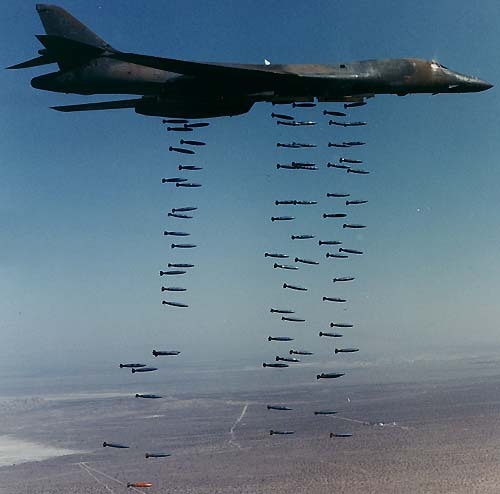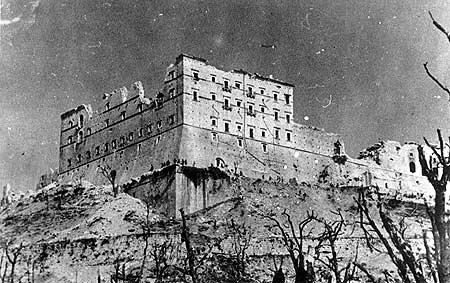lundi, 29 juin 2015
Carpet-Bombing History

Carpet-Bombing History
J. E. Curtis, Keeper of the British Museum’s Middle East collections, was on grim business in Iraq. Armed occupiers held an ancient city there—“tantamount to establishing a military camp around the Great Pyramid in Egypt or around Stonehenge in Britain,” he wrote. The site was “irrevocably contaminated,” he added, suffering “permanent damage that will last forever.”
Curtis was describing Babylon in 2004, under U.S. occupation. But commentary on ISIS ignores Washington’s legacy of cultural ruin, assuming Islamic State has some unique capacity for wrecking artifacts. The group’s “obliterators,” as historian Simon Schama termed them, “all act from the same instinct of cultural panic that the supreme works of the past will lead people astray from blind, absolute obedience.” Toppling Palmyra would reveal “Isis’s littleness,” architecture critic Rowan Moore asserted, asking “how could anyone be so threatened by ancient ruins, unless they lacked belief in their ability to create something themselves?”
“Palmyra,” Moore emphasized, “is an ancient Roman site whose significance and value is exceeded by very few others: those in Rome itself, Pompeii, possibly Petra in Jordan.” So in his view, a “littleness” rivaling Islamic State’s would motivate, say, bombing raids on Pompeii—which the U.S. and British Air Forces carried out in 1943. The first strike happened August 24, “ironically the anniversary of the eruption of Vesuvius,” according to the Getty Museum’s Kenneth Lapatin. “Damage was incurred at various points throughout the archaeological site (over 160 hits were recorded), and some of its most famous monuments were struck,” with dozens “totally destroyed,” he explains.
The Allies bombed the Cathedral of Benevento that same month. “For 1,100 years this medieval church stood as a small but precious religious monument,” LIFE reported, though after the attack only “the bell tower, parts of the façade and one side wall” remained. “Fire that swept the cathedral burned rare Sixth Century Langobardic manuscripts,” though perhaps “the loss of the cathedral’s famous 12th Century bronze doors” was worse.

Six months later, in February 1944, Allied bombers demolished the Abbey of Monte Cassino, where “the only people killed,” David Hapgood and David Richardson clarify, “were among the civilians.” Dating from the 6th century, the Abbey was “the site where St. Benedict himself had founded the world-famed Benedictine Order,” John S. D. Eisenhower noted. He pointed out that Nazi officials ordered Monte Cassino’s Abbot, Gregorio Diamare—who “could not bring himself to believe that the Allies would destroy such a venerated edifice as the Abbey”—to send its art and archives to a safe location.
Allied bombers brutalized German historic sites for the rest of the war. “The center of Trier, for instance, was subjected to twenty raids between 14 August and 24 December 1944, causing severe damage to the fourth-century AD basilica and the Liebfrauenkirche, one of the oldest Gothic churches in Germany,” Nicola Lambourne writes. After the January 1945 raid on Nuremberg, much “of the historic center was destroyed, including the Albrecht Dürer house and the nineteenth-century building housing the German National Museum.” Sönke Neitzel explains that the February 1945 attack on Dresden badly damaged nineteen of the city’s thirty most significant cultural structures, leveling the other eleven.
And the U.S. Army Air Forces, while firebombing Japan, leveled Kobe’s 700-year-old Yakusenji Temple, Nagoya’s 17th-century Castle, and Tokyo’s Taitokuin mausoleum—“a spectacular complex,” historian William H. Coaldrake affirms—built in 1632. Mark Michael Rowe writes that “Isshinji, an extremely popular Jōdo temple in Osaka, began collecting anonymous remains in 1887. The ashes were ground up, combined with concrete and molded into life-sized, seated Bone Buddha statues.” When U.S. incendiaries razed it, “the remains of nearly one million people, abandoned and otherwise, had been entrusted to the temple.” Washington’s campaign to ignite these cities also “accounted either directly or indirectly for the destruction of 50 percent of the total book resources in Japanese libraries,” Rebecca Knuth writes.
The destruction was equally broad in North Korea, years later. “Pyongyang is usually presented as an ancient city,” Andrei Lankov observes. “The area has been the site of a major settlement for nearly two millennia,” he acknowledges, but adds that “the present Pyongyang was built almost from scratch in the mid-1950s”—mainly because “a major US bombing campaign that reached its height in 1952” wiped out “some 90 percent of the city,” erasing much of its history. Justin Corfield, in his Historical Dictionary of Pyongyang, lists what was lost. The Kwangbop Buddhist Temple dated to 392; Potong Gate “was one of the ancient city gates of the walled city of Pyongyang, built in the mid-sixth century;” Sungryong Hall, a temple, “was built in 1429,” and like the other structures “destroyed during the Korean War,” Corfield concludes.
Or consider Mỹ Sơn Sanctuary. The Global Heritage Fund explains it “is one of Vietnam’s only archaeological sites to be inscribed as a UNESCO World Heritage site and was inhabited from the 4th- through the 15th centuries AD,” when the Champa Kingdom blossomed. But “a large majority of Mỹ Sơn’s exquisite architecture was destroyed by aerial bombing during a single week of the Vietnam War.” A team of scholars, involved in the “ongoing conservation effort” there, admit their work “cannot change one sad truth: one of the towers that the [B-52] bombing crew saw that day [in August 1969], the temple once described as the ‘most perfect expression of Cham architecture,’ is gone forever.’”
Anthropologist Christina Schwenkel uncovered “another buried history of US aerial bombing in Vietnam: that of the demolished city of Vinh, provincial capital of Nghệ An.” From 1964-1973, “the city was subjected to more than 4,700 air strikes,” during which its “historical and cultural patrimony”—including the 18th-century Diệc Pagoda and 19th-century imperial citadel—was finished off. Mervyn Brown, in his memoir recounting years spent in Laos, describes a similar U.S. bombing. “The destruction of Xieng Khouang, a former royal capital with many beautiful temples and other buildings of historical and artistic interest, was a particular act of cultural vandalism.” The ruin was so complete “that it was not feasible to rebuild the town,” he laments.
There were, in other words, precedents for what the British Museum’s Curtis saw in U.S.-occupied Babylon. And that city’s damage stemmed from Washington’s antiquities policy. “During preparations for the 2003 war on Iraq,” writes journalist Robert Bevan, “US military planners identified 150 important archaeological sites to be avoided. US archaeologists responded with a list of 4,000 vital locations—a degree of ‘duty of protection’ that the Pentagon rejected despite international law demanding it.” Familiar results followed. Vandals torched the National Library and Archives and the Ministry of Religious Endowment’s Koranic Library. Looters hit the Museum of Archaeology. “The US forces did not seek to prevent the destruction here and elsewhere,” Bevan argues, “despite being implored to do so.”
“Why does the nihilistic effort to wipe out an ancient civilization echo so strongly?” Thanassis Cambanis asked in the Boston Globe. He was writing about ISIS, with justifiable outrage. But we should ask another question: Why doesn’t Washington’s global bombing of cultural sites—accompanying mass slaughter—echo at all?
Nick Alexandrov lives in Washington, DC. He can be reached at: nicholas.alexandrov@gmail.com
00:05 Publié dans Histoire | Lien permanent | Commentaires (0) | Tags : histoire, stratégie |  |
|  del.icio.us |
del.icio.us |  |
|  Digg |
Digg | ![]() Facebook
Facebook



Les commentaires sont fermés.